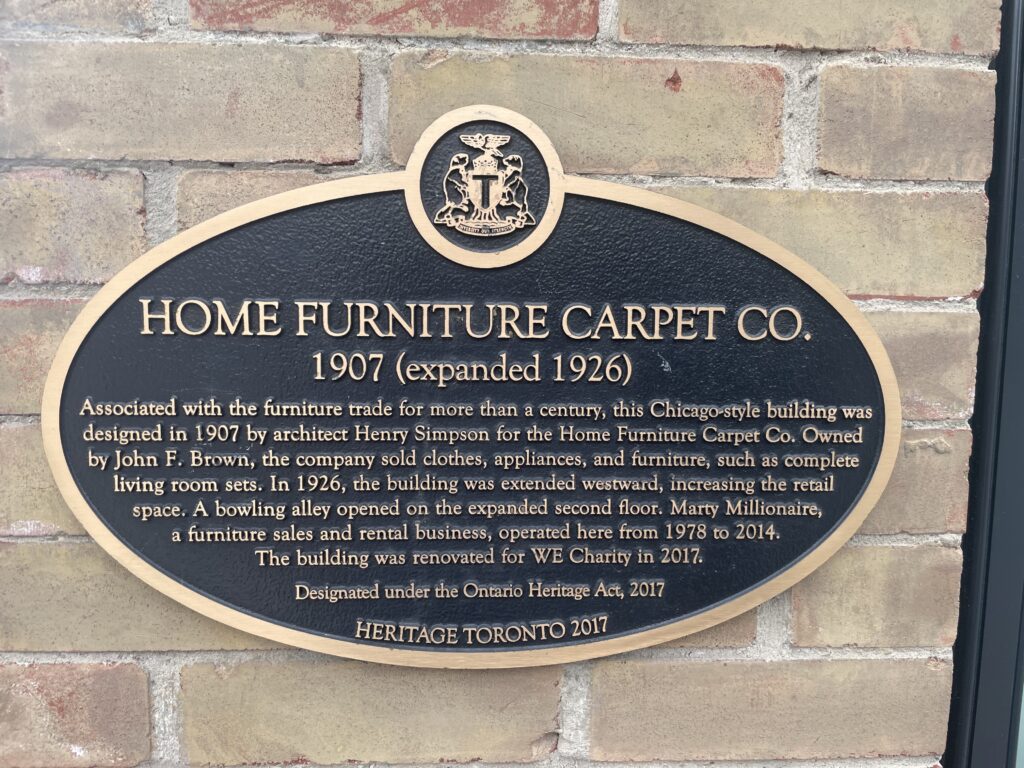By Andre Bermon, Publisher –
History is a collection of narratives woven together to evaluate the importance of a person, place or event. Stories get left out, sometimes arbitrarily. At least that’s what one Ontario family thinks.
A plaque at 339 Queen Street East, a heritage building on the corner of Parliament Street, has sparked a historical controversy. Grant and Ron Tadman, blame Heritage Toronto, a city agency that installed the plaque in 2017, for a significant omission. Their grandfather, Cecil B. Tadman, a previous owner of the building and operator of the now-defunct Home Furniture Company Limited from 1928-1976, was left off the commemorative plaque.
Heritage Toronto told the Tadmans the decision to omit reference to Cecil Tadman and his store was editorial – information they deemed not in the public’s interest.
For the Tadman brothers the failure to recognize their ancestor’s half-century legacy engendered disbelief. “It’s [Heritage Toronto’s] job to present educational material to the public…and to lop off 50 years without a valid reason … come on guys, there’s got to be some common sense here,” Ron Tadman told the bridge.
According to email correspondence shared by the Tadmans, Alan Tadman, a cousin of Grant and Ron, first approached Heritage Toronto about replacing the plaque in late 2020. The response by Heritage Toronto’s manager of plaques and public education, Chris Bateman, was cordial but ultimately adamant.
Policy dictates that unless there is a harmful error or a “substantial omission,” no changes would be made, he said. This was echoed by Heritage Toronto’s executive director, Allison Bain.
“They’re incredibly defiant,” said Grant Tadman. He offered to pay the cost of replacing the plaque, estimated at $3500, “but they just dug in their heels and refused to respond to anything.”
From the family’s perspective, the significant time their grandfather’s business occupied 339 Queen made replacing the plaque reasonable. Cecil Tadman worked for the building’s original owner, John F. Brown, before purchasing it in 1928 and changing the business name from Home Furniture Carpet Company to Home Furniture Company Limited. He retired in 1976 and the family sold the building to Marty Nefsky, founder of Marty Millionaire, two years later.
For the Tadman brothers, getting their grandfather recognized in Toronto history is as much about principle as celebrating a Canadian entrepreneur.
“Cecil Tadman was a man devoted to his work and his company,” Ron Tadman wrote. “He worked tirelessly, six days a week from 1928 to 1976, to ensure his business was successful.”
According to the family, Cecil contributed to the community by granting customer credit during and after the Great Depression. “Customers were able to improve the quality of their lives by taking delivery of goods that they would otherwise not be able to purchase…Back in the 1930s and ’40 ‘s not every store owner granted and managed credit. Cecil did.”

The plaque at 339 Queen is engraved with the title “Home Furniture Carpet Co. – 1907 (expanded 1926).” It commemorates the building’s architect, Henry Simpson, and the business (Home Furniture Carpet Company) for which the structure was commissioned.
The plaque names the original business owner, John F. Brown, what the store sold and the 1926 extension that led to the opening of a second-floor bowling alley. The plaque also notes the purchase by Marty Millionaire, who ran a furniture sales and rental business from 1978 to 2014. Lastly, it cites the building’s renovation by WE Charity, the former social enterprise led by the Kielburger brothers. The building was briefly WE Charity’s global headquarters before being sold after a scandal involving the Trudeau government.
“After the Home Furniture Carpet Company, the next reference to anything was 1978 …that is totally misleading,” lamented Ron Tadman.
The brothers point to a Heritage Property Research and Evaluation Report, prepared by City Planning’s Preservation Services. Published in 2015 and presented to City Council to support the building’s heritage designation, the 25-page report highlights the merits of 339 Queen Street East, including the building’s timeline.
As in the plaque, Cecil Tadman and the Home Furniture Company is conspicuously missing from the report.
When the Tadman brothers spoke to its author, city planner Marybeth McTeague, she admitted to making a mistake but gave no sign of rectifying it. She later retired.
Grant and Ron Tadman theorize that Heritage Toronto failed to do its own research and instead relied upon the planner’s findings. Its refusal to replace the plaque was more about covering up their mistake than fulfilling agency mandates, they believe.
The discrepancy was big enough to warrant a review from the Toronto Ombudsman, which the Tadmans solicited in 2021. The Ombudsman’s verdict, published the following year, sided with the agency. It said Heritage Toronto is “entitled to make decisions as part of fulfilling their mandate” and that their “application of the [plaque] policy was reasonable.”
The Ombudsman stated that Heritage Toronto did not solely rely on City Planning’s heritage report but conducted independent research from publicly accessible sources. The report declares that “some documents” had been collected, including a 1935 directory showing Cecil Tadman listed as president of the Home Furniture Company Limited.
In addition to seeking review from the Ombudsman, the Tadmans contacted city councillors Paula Fletcher, who sits on Heritage Toronto’s board, and Ward 13 councillor Chris Moise. But they received no support.
Despite nearly three years of disappointing outcomes, the Tadman family refuses to give up. “Heritage Toronto’s mandate is simply wrong,” said Grant Tadman.
Heritage Toronto did not comment for this piece.




